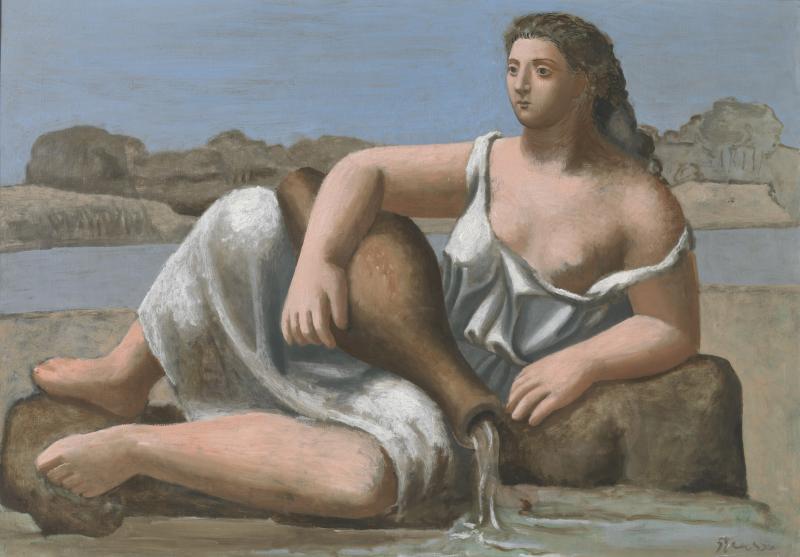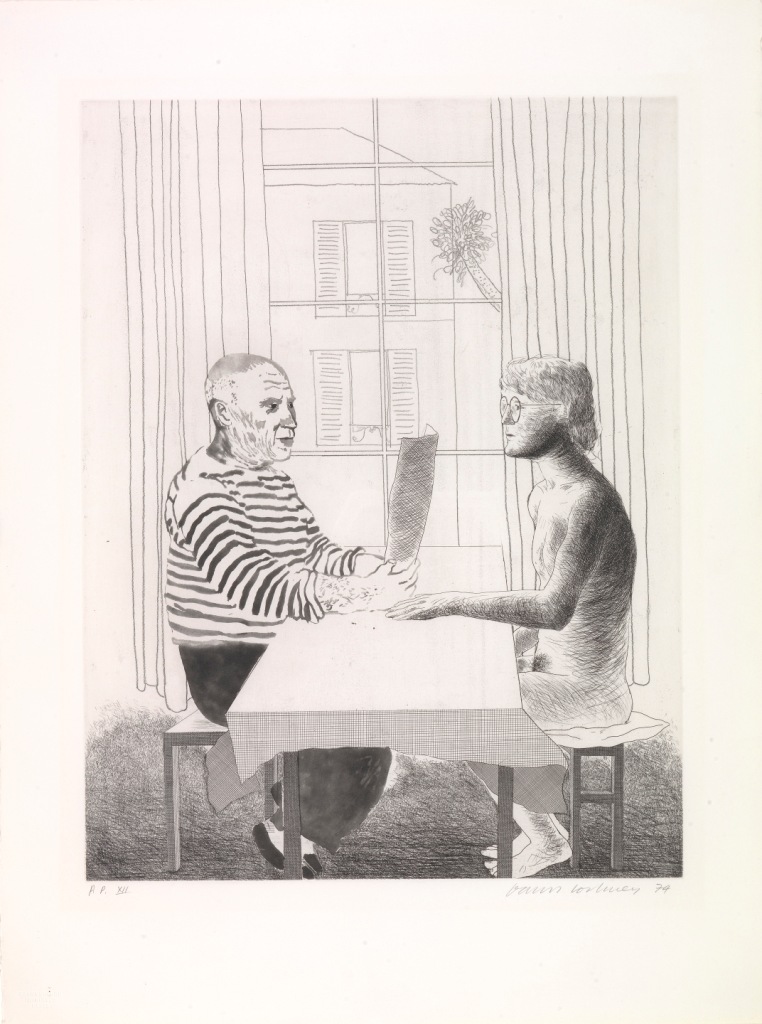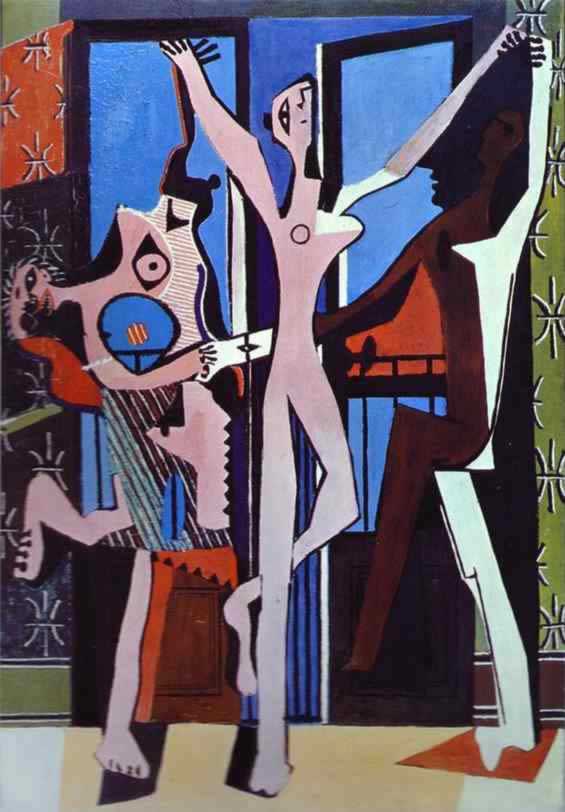Picasso and Modern British Art, Tate Britain | reviews, news & interviews
Picasso and Modern British Art, Tate Britain
Picasso and Modern British Art, Tate Britain
How the colossus of modern art influenced seven prominent UK artists

Pablo Picasso is the presiding genius of 20th century art, the most influential artist in the modern period, lauded for his protean inventiveness, originality, individuality and overwhelming productivity. In 1934 poet Geoffrey Grigson declared that he was all the history of modern art, in 1942 the artist Jankel Adler observed that “Picasso, the greatest innovator of the twentieth century, has knocked on the door of every painter’s studio in the world”.
It is in the shadow of this colossus that Tate Britain's new exhibition unfolds, selecting seven British artists from the scores available who have been consciously influenced by the master. Some 60 Picassos covering all periods, shown in Britain and/or purchased by British collectors, are also on view (although for reasons either financial, or due to a failure of public nerve, significant numbers in both categories are now in European or American collections). Many of them are in intimate dialogue with the work of the anointed seven British artists, four of whom not only absorbed Picasso's art but knew the man himself. (Pictured below: David Hockney, Artist and Model, 1973-4)

There are several surprises: first, the relatively tame, even charming small Picassos from the turn of the last century, which were readily collected: rooftops, a race course, even a flowery still life of 1901, the last purchased for the Tate in 1933 with the help of that pioneering charity The Contemporary Art Society. Second, the masterpieces we do have on public view. GIven a gallery of its own, The Three Dancers, 1925, is the climax of the show: it was thought by Picasso to be second only among his work to Les Demoiselles d’Avignon (Museum of Modern Art, New York).
 The negotiations in the 1960s for The Three Dancers (pictured left) were led by Roland Penrose, collector, artist, friend, amanuensis and the author of the first major biography of his idol in English. It is from Penrose’s collection that another undoubted masterpiece also entered the Tate: The Weeping Woman, 1937, refers not only to Dora Maar, the savagely intelligent mistress of the late 1930s, but also the painful suffering of the Spanish Civil War, .
The negotiations in the 1960s for The Three Dancers (pictured left) were led by Roland Penrose, collector, artist, friend, amanuensis and the author of the first major biography of his idol in English. It is from Penrose’s collection that another undoubted masterpiece also entered the Tate: The Weeping Woman, 1937, refers not only to Dora Maar, the savagely intelligent mistress of the late 1930s, but also the painful suffering of the Spanish Civil War, .
Penrose had a long and highly emotional relationship with Picasso, and as the curator of the sensationally successful 1960 Tate retrospective – seen by half a million people – pointed out that it was Picasso who persuaded the world of the validity of art as the powerful emotional medium that we now take for granted. Nude, Green Leaves and Bust, 1932, on loan to Tate from a private collection, is one of the huge, swooning, possibly post-coital studies of the warmly pink and naked Marie Therese, the very young mistress of the early 1930s. The undoubtedly great works, encompassing cubism, classicism and late transcriptions from, for example, Velazquez's Las Meninas, cover his entire career; a number of bagatelles provide the welcome opportunity to pause and catch a breath.
We are so accustomed to the timidity and reticence that for much of the past century characterised both British art and British public collecting that the genuine surprise is how several British artists more than hold their own. Henry Moore met Picasso in Paris with a group of leading surrealists, invited to the studio to watch Picasso at work on Guernica. But the influence was acknowledged from the 1920s, and the terrific selection on view pits Moore’s magnificent Reclining Figure, 1936 (pictured below), carved in elmwood, against an almost identical pose in Picasso’s classicised La Source of 1921 (see main image).
 There is a poignant shared sensibility; Moore’s tiny bronze, Three Points, 1939-40, has a spiky emotional expressiveness prefigured in Picasso’s Standing Nude of 1928. Francis Bacon credited his visit to a Picasso exhibition in Paris in the 1920s to opening his mind to the possibilities of painting. Bacon’s terrifying distortions of the 1930s and 1940s are seen as directly related to the telling twists of the human figure at which Picasso was so adept. David Hockney’s playful posthumous homages are welcome light relief.
There is a poignant shared sensibility; Moore’s tiny bronze, Three Points, 1939-40, has a spiky emotional expressiveness prefigured in Picasso’s Standing Nude of 1928. Francis Bacon credited his visit to a Picasso exhibition in Paris in the 1920s to opening his mind to the possibilities of painting. Bacon’s terrifying distortions of the 1930s and 1940s are seen as directly related to the telling twists of the human figure at which Picasso was so adept. David Hockney’s playful posthumous homages are welcome light relief.
The intertwining and interplay of artists, their art, and the ways in which art reaches the public has never been more intelligently visible, nor the distance between genius and talent.
rating
Buy
Explore topics
Share this article
The future of Arts Journalism
You can stop theartsdesk.com closing!
We urgently need financing to survive. Our fundraising drive has thus far raised £49,000 but we need to reach £100,000 or we will be forced to close. Please contribute here: https://gofund.me/c3f6033d
And if you can forward this information to anyone who might assist, we’d be grateful.

Subscribe to theartsdesk.com
Thank you for continuing to read our work on theartsdesk.com. For unlimited access to every article in its entirety, including our archive of more than 15,000 pieces, we're asking for £5 per month or £40 per year. We feel it's a very good deal, and hope you do too.
To take a subscription now simply click here.
And if you're looking for that extra gift for a friend or family member, why not treat them to a theartsdesk.com gift subscription?
more Visual arts
 'We are bowled over!' Thank you for your messages of love and support
Much-appreciated words of commendation from readers and the cultural community
'We are bowled over!' Thank you for your messages of love and support
Much-appreciated words of commendation from readers and the cultural community
![SEX MONEY RACE RELIGION [2016] by Gilbert and George. Installation shot of Gilbert & George 21ST CENTURY PICTURES Hayward Gallery](https://theartsdesk.com/sites/default/files/styles/thumbnail/public/mastimages/Gilbert%20%26%20George_%2021ST%20CENTURY%20PICTURES.%20SEX%20MONEY%20RACE%20RELIGION%20%5B2016%5D.%20Photo_%20Mark%20Blower.%20Courtesy%20of%20the%20Gilbert%20%26%20George%20and%20the%20Hayward%20Gallery._0.jpg?itok=7tVsLyR-) Gilbert & George, 21st Century Pictures, Hayward Gallery review - brash, bright and not so beautiful
The couple's coloured photomontages shout louder than ever, causing sensory overload
Gilbert & George, 21st Century Pictures, Hayward Gallery review - brash, bright and not so beautiful
The couple's coloured photomontages shout louder than ever, causing sensory overload
 Lee Miller, Tate Britain review - an extraordinary career that remains an enigma
Fashion photographer, artist or war reporter; will the real Lee Miller please step forward?
Lee Miller, Tate Britain review - an extraordinary career that remains an enigma
Fashion photographer, artist or war reporter; will the real Lee Miller please step forward?
 Kerry James Marshall: The Histories, Royal Academy review - a triumphant celebration of blackness
Room after room of glorious paintings
Kerry James Marshall: The Histories, Royal Academy review - a triumphant celebration of blackness
Room after room of glorious paintings
 Folkestone Triennial 2025 - landscape, seascape, art lovers' escape
Locally rooted festival brings home many but not all global concerns
Folkestone Triennial 2025 - landscape, seascape, art lovers' escape
Locally rooted festival brings home many but not all global concerns
 Sir Brian Clarke (1953-2025) - a personal tribute
Remembering an artist with a gift for the transcendent
Sir Brian Clarke (1953-2025) - a personal tribute
Remembering an artist with a gift for the transcendent
 Emily Kam Kngwarray, Tate Modern review - glimpses of another world
Pictures that are an affirmation of belonging
Emily Kam Kngwarray, Tate Modern review - glimpses of another world
Pictures that are an affirmation of belonging
 Kiefer / Van Gogh, Royal Academy review - a pairing of opposites
Small scale intensity meets large scale melodrama
Kiefer / Van Gogh, Royal Academy review - a pairing of opposites
Small scale intensity meets large scale melodrama
 Jenny Saville: The Anatomy of Painting, National Portrait Gallery review - a protégé losing her way
A brilliant painter in search of a worthwhile subject
Jenny Saville: The Anatomy of Painting, National Portrait Gallery review - a protégé losing her way
A brilliant painter in search of a worthwhile subject
 Abstract Erotic, Courtauld Gallery review - sculpture that is sensuous, funny and subversive
Testing the boundaries of good taste, and winning
Abstract Erotic, Courtauld Gallery review - sculpture that is sensuous, funny and subversive
Testing the boundaries of good taste, and winning
 Edward Burra, Tate Britain review - watercolour made mainstream
Social satire with a nasty bite
Edward Burra, Tate Britain review - watercolour made mainstream
Social satire with a nasty bite
 Ithell Colquhoun, Tate Britain review - revelations of a weird and wonderful world
Emanations from the unconscious
Ithell Colquhoun, Tate Britain review - revelations of a weird and wonderful world
Emanations from the unconscious

Add comment